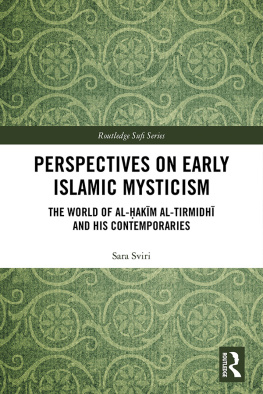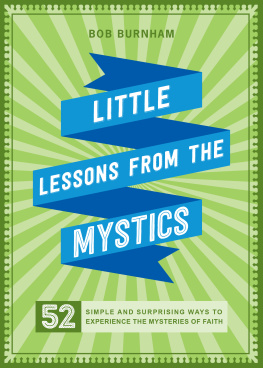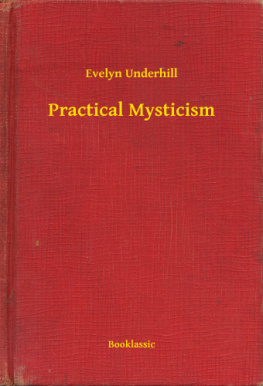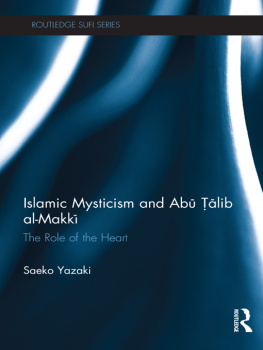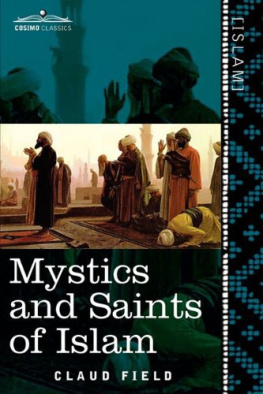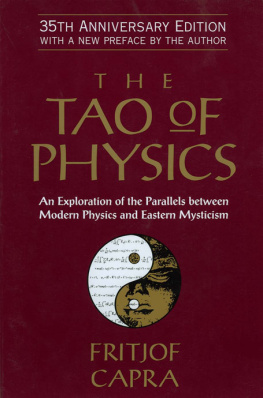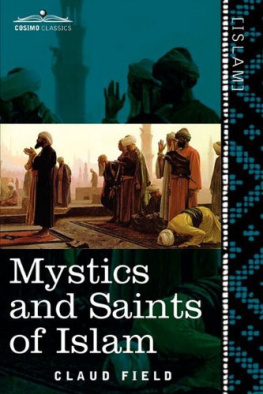Table of Contents
Guide
Print Page Numbers
Perspectives on Early Islamic Mysticism
This monograph explores the original literary produce of Muslim mystics during the eighthtenth centuries, with special attention to ninth-century mystics, such as al-Tustar, al-Musib, al-Kharrz, al-Junayd and, in particular, al-akm al-Tirmidh. Unlike other studies dealing with the so-called Formative Period, this book focuses on the extant writings of early mystics rather than on the later f compilations.
These early mystics articulated what would become a hallmark of Islamic mysticism: a system built around the psychological tension between the self (nafs) and the heart (qalb) and how to overcome it. Through their writings, already at this early phase, the versatility, fluidity and maturity of Islamic mysticism become apparent. This exploration thus reveals that mysticism in Islam emerged earlier than customarily acknowledged, long before Islamic mysticism became generically known as fism.
The central figure of this book is al-akm al-Tirmidh, whose teaching and inner world focus on themes such as polarity, the training of the self, the opening of the heart, the Friends of God (al-awliy), dreams and visions, divine language, mystical exegesis and more.
This monograph thus offers a fuller picture than hitherto presented of the versatility of themes, processes, images, practices, terminology and thought models during this early period. The volume will be a key resource for scholars and students interested in the study of religion, f studies, Late Antiquity and Medieval Islam.
Sara Sviri is Professor Emerita at the Department of Arabic and the Department of Comparative Religions of The Hebrew University of Jerusalem. She had also taught at the Department of Hebrew and Jewish Studies, University College London and at The Institute of Jewish Studies, University of Oxford. Her fields of study include Islamic mysticism, mystical philosophy, comparative aspects of Early Islam, the formative period of Islamic mysticism, Medieval Jewish mysticism and the mystical wisdom of Ibn al-Arab. Her book The Taste of Hidden Things: Images on the Sufi Path was published in 1997. Her comprehensive Sufi Anthology was published in Hebrew in 2008. The Arabic version of the Anthology came out in Beirut by Manshrt al-jamal (2016).
Routledge Sufi Series
General Editor: Ian Richard Netton
Professor of Islamic Studies, University of Exeter
The Routledge Sufi Series provides short introductions to a variety of facets of the subject, which are accessible both to the general reader and the student and scholar in the field. Each book will be either a synthesis of existing knowledge or a distinct contribution to, and extension of, knowledge of the particular topic. The two major underlying principles of the Series are sound scholarship and readability.
Ibn al-Arab and Islamic Intellectual Culture
From Mysticism to Philosophy
Caner K. Dagli
Sufism and Jewish-Muslim Relations
The Derekh Avraham Order
Yafiah Katherine Randall
Practicing Sufism
Sufi Politics and Performance in Africa
Edited by Abdelmajid Hannoum
Awad al-Dn Kirmn and the Controversy of the Sufi Gaze
Lloyd Ridgeon
Sufism in Ottoman Egypt
Circulation, Renewal and Authority in the Seventeenth and Eighteenth Centuries
Rachida Chih
Perspectives on Early Islamic Mysticism
The World of al-akm al-Tirmidh and his Contemporaries
Sara Sviri
For more information about this series, please visit: www.routledge.com/middleeaststudies/series/SE0491
Perspectives on Early Islamic Mysticism
The World of al-akm al-Tirmidh and his Contemporaries
Sara Sviri

First published 2020
by Routledge
2 Park Square, Milton Park, Abingdon, Oxon OX14 4RN
and by Routledge
52 Vanderbilt Avenue, New York, NY 10017
Routledge is an imprint of the Taylor & Francis Group, an informa business
2020 Sara Sviri
The right of Sara Sviri to be identified as author of this work has been asserted by her in accordance with sections 77 and 78 of the Copyright, Designs and Patents Act 1988.
All rights reserved. No part of this book may be reprinted or reproduced or utilized in any form or by any electronic, mechanical, or other means, now known or hereafter invented, including photocopying and recording, or in any information storage or retrieval system, without permission in writing from the publishers.
Trademark notice: Product or corporate names may be trademarks or registered trademarks, and are used only for identification and explanation without intent to infringe.
British Library Cataloguing-in-Publication Data
A catalogue record for this book is available from the British Library
Library of Congress Cataloging-in-Publication Data
A catalog record has been requested for this book
ISBN: 978-0-415-30283-8 (hbk)
ISBN: 978-0-203-02272-6 (ebk)
Typeset in Times New Roman
by Wearset Ltd, Boldon, Tyne and Wear
To Paul Nwyia, with admiration for his pioneering work
Contents
The chapters collected in this monograph reflect years of studying Islamic Mysticism, in particular its early phases. It all started with taking up Arabic at school. Hence, first and foremost, my deepest gratitude and indebtedness go to the late Prof. Meir J. Kister, my Arabic teacher and mentor first at high school and then at university. Kister was an inspiring teacher not only for me. It can be clearly stated, that inspiration and enthusiasm are not confined to the realm of mysticism.
Deep gratitude and indebtedness I wish to extend to Prof. Shaul Shaked. He supervised my by now ancient dissertation on al-akm al-Tirmidh. During a difficult and turbulent period in my life, Shaul Shakeds commitment, support, expertise and understanding had been essential for the completion of my doctorate.
From among my friends and colleagues at the department of Arabic Language and Literature and the Department of Comparative Religion at the Hebrew University, deep gratitude goes to Ella Almagor, Yohanan Friedman, Sarah and Guy Stroumsa, David Shulman, Bruria Bitton-Ashkeloni, Reuven Amitai, Meir Bar-Asher, Meir Hatina and Etan Kohlberg. Their abiding friendship had been there for me at times of presence and absence. Sharing with them preliminary thoughts and drafts were vital for my attempts at processing and articulating the vast material at hand.
The idea of the monograph came up years ago when I met Ian Netton in Oxford. He suggested that I submit a proposal for a book on al-akm al-Tirmidh to the Sufi Studies Series of which he had been the editor. Although a proposal had been submitted, circumstances intervened to postpone the actual writing of the monograph. A few years ago, at a conference in Exeter, I again met Ian and raised the idea of resurrecting the old proposal. Ian, as ever the editor of Routledge Sufi Series, was forthcoming and supportive and referred me to Joe Whiting at Routledge. Eventually, the manuscript was submitted in February 2019 and was immediately placed in the capable and receptive hands of Titanilla Panczel, an editorial assistant of the Middle Eastern, Islamic and Jewish Studies at Routledge, Taylor and Francis Group. A very special gratitude I hence forward to Ian Netton, Joe Whiting and Titanilla Panczel, three helpful agents in the process of publishing the book.

